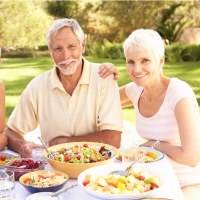 The number of older adults in the world is growing both in absolute and relative terms. The greatest challenge over the coming years will be maintaining the health of this increasing number of older adults.
The number of older adults in the world is growing both in absolute and relative terms. The greatest challenge over the coming years will be maintaining the health of this increasing number of older adults.
Deciding what we mean by ‘older people’ is a little arbitrary. The World Health Organization classifies people aged between 45 and 59 as ‘middle age’, 60 to 74 as ‘elderly’ and over 75 as ‘old’. The nutritional needs of older adults are difficult to neatly categorise into absolute age groups..
Nutrition for generally fit and healthy older adults
Activity: Research shows that remaining active can help to maintain both mental and physical health. Remember, activity doesn’t necessarily mean joining an exercise class. Gardening, walking to the shops and housework can all count as types of activity too.
Energy: Energy requirements can decline with age, particularly if physical activity is limited. It’s vital that food choices are nutritionally dense, which means you still need to eat a variety of foods, with fewer calories.
Fat: Advice to restrict fat intake, particularly cutting saturated fat to improve heart health, remains true for older people who are fit and well.
Fibre: Older people can suffer from constipation and bowel problems mainly due to a reduced gut motility and inactivity. To relieve this, try eating high-fibre cereal foods, fruit and vegetables.
Fluid: Dehydration can make people feel drowsy or confused, it’s important to drink, even if this means extra trips to the toilet. The risk of dehydration can be higher in older people because their kidneys don’t function as efficiently as those of younger people.
Sugar: Generally fit and healthy older people should limit foods and drinks that are rich in sugar, as it can impair dental health and contribute to weight gain when energy intake is too high.
Iron: Anaemia is common in older adults. Poor absorption of iron, due to changes in the gastrointestinal tract, blood loss and the use of certain drugs – together with a poor dietary intake – may be casual factors
Zinc: Zinc is needed for a healthy immune system and to support the healing of wounds including pressure ulcers. Rich sources include meat, pulses, whole-meal bread and shellfish.
Calcium and vitamin D: Adequate intake of calcium and vitamin D may help to slow the rate of calcium loss from bones, which starts at the age of 30 and accelerates considerably in later years.
Vitamin C: Older people may have low vitamin C intakes if not consuming enough fruit and vegetables. This may be because crisp fruit and vegetables are often avoided if their teeth are in poor condition or if they have badly fitting dentures. Regular check-ups with the dentist can help to ensure that teeth remain healthy, enabling older people to continue to enjoy a variety of foods that will help maintain overall health.
Foods to choose:
To meet your nutritional needs, aim to eat a varied diet including regular meals and snacks, and drink enough fluid.
Sometimes older people can no longer eat as much food at a single sitting, so include more nutritious snacks in between meals to boost nutrient intake.

Wow, amazing weblog layout! How long have you been running a blog for?
you make blogging look easy. The overall look of your
website is excellent, let alone the content material! You can see similar here
sklep online
Thanks for sharing your info. I truly appreciate your efforts and I will be waiting for your further write ups thanks once again. I
saw similar here: Ecommerce
Hi there! Do you know if they make any plugins to
help with Search Engine Optimization? I’m trying to get my blog to
rank for some targeted keywords but I’m not seeing
very good results. If you know of any please share.
Many thanks! You can read similar blog here: Sklep
It’s very interesting! If you need help, look here: ARA Agency
Thanks for sharing. I read many of your blog posts, cool, your blog is very good.
Can you be more specific about the content of your article? After reading it, I still have some doubts. Hope you can help me.
利用强大的谷歌蜘蛛池技术,大幅提升网站收录效率与页面抓取频率。谷歌蜘蛛池
Tham gia cộng đồng game thủ tại Go88 để trải nghiệm các trò chơi bài, poker phổ biến nhất hiện nay.
专业构建与管理谷歌站群网络,助力品牌实现全域流量的强势增长。谷歌站群
苹果签名,苹果超级签平台,ios超级签平台ios超级签苹果企业签,苹果超级签,稳定超级签名
kuwin sở hữu kho game đa dạng từ slot đến trò chơi bài đổi thưởng, mang đến cho bạn những giây phút giải trí tuyệt vời.
Khám phá thế giới giải trí trực tuyến đỉnh cao tại MM88, nơi mang đến những trải nghiệm cá cược thể thao và casino sống động.
Đến với J88, bạn sẽ được trải nghiệm dịch vụ cá cược chuyên nghiệp cùng hàng ngàn sự kiện khuyến mãi độc quyền.